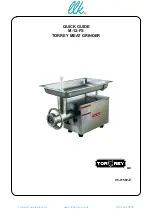
3
■
WEAR APPROPRIATE CLOTHING. Do not wear loose
clothing, neckties, or jewelry that can get caught in the
tool’s moving parts and cause personal injury, Non-
solid footwear is recommended when working
outdoors. Wear protective hair covering to contain long
hair.
■
ALWAYS WEAR SAFETY GLASSES WITH SIDE
SHIELDS. Everyday eyeglasses are NOT safety
glasses.
■
PROTECT YOUR LUNGS. Wear a face or dust mask if
the cutting operation is dusty.
■
PROTECT YOUR HEARING. Wear hearing protection
during extended periods of operation.
■
DON’T ABUSE CORD. Never carry tool by the cord or
yank it to disconnect from receptacle. Keep cord away
from heat, oil, and sharp edges.
■
DO NOT OVERREACH. Keep proper footing and
balance at all times.
■
MAINTAIN TOOLS WITH CARE. Keep tools sharp and
clean for best and safest performance. Follow
instructions for lubricating and changing accessories.
■
NEVER LEAVE TOOL RUNNING UNATTENDED.
TURN POWER OFF. Disconnect all tools when not in
use, before servicing, or when changing attachments,
wheels, etc.
■
AVOID ACCIDENTAL STARTING.
■
USE RECOMMENDED ACCESSORIES. The use of
improper accessories may cause risk of injury.
■
DO NOT use wheels with incorrect size bore. NEVER
use wheel washers or wheel that are defective or
incorrect and NEVER touch grinding wheel or other
moving parts.
■
NEVER STAND ON TOOL. Serious injury could occur
if the tool is tipped or if the wheel is unintentionally
contacted.
■
DIRECTION OF FEED. Be aware of wheel rotation
direction; never grind without the work rest being
properly set. NEVER grind more than one workpiece at
a time.
WARNING
Wheel coasts after turn off.
■
CHECK DAMAGED PARTS. Before further use of the
tool, a guard or other part that is damaged should be
carefully checked to determine that it will operate
properly and perform its intended function. Check for
alignment of moving parts, binding of moving parts,
breakage of parts, mounting and any other conditions
that may affect its operation. A guard or other part that
is damage must be properly repaired or replaced by an
authorized service center to avoid risk of personal
injury.
■
KEEP TOOL DRY, CLEAN, AND FREE FROM OIL
AND GREASE. Always use a clean cloth when
cleaning. Never use brake fluids, gasoline, petroleum-
based products, or any solvents to clean tool.
■
INSPECT POWER SUPPLY AND EXTENSION
CORDS periodically and, if damaged, have repaired by
a qualified service technician. Stay constantly aware of
cord location and keep it well away from the rotating
wheel.
■
NEVER USE IN AN EXPLOSIVE ATMOSPHERE.
Normal sparking of the motor or sparking from grinding
metal could ignite fumes.
■
USE OUTDOOR EXTENSION CORDS. Use only
extension cords with approved ground connection that
are intended for use outdoors and so marked.
■
NEVER reach to pick up a workpiece, a piece of scrap,
or anything else that is in or near the grinding path of
the wheel.
■
AVOID AWKWARD OPERATIONS AND HAND
POSITIONS where a sudden slip could cause your
hand to move into the wheel. ALWAYS make sure you
have good balance.
■
NEVER stand or have any part of your body in line with
the path of the wheel.
■
DO NOT USE TOOL IF SWITCH DOES NOT TURN IT
ON AND OFF. Have defective switches replaced by an
authorized service center.
■
DO NOT TURN THE MOTOR SWITCH ON AND OFF
RAPIDLY. This could cause the wheel to loosen and
could create a hazard. Should this ever occur, stand
clear and allow the wheel to come to a complete stop.
Disconnect your grinder from the power supply and
securely retighten the wheel nut.
WARNING:
When servicing use only identical replacement parts. Use
of any other parts may create a hazard or cause product
damage.
■
USE ONLY FLANGES supplied with this bench grinder.
IF ANY PART OF THIS GRINDER IS MISSING or
should break, bend, or fail in any way, or should any
electrical component fail to perform properly, shut off
the power switch, remove the machine plug from the
power source and have damaged, missing, or failed
parts replaced before resuming operation.
■
MAKE SURE THE GRINDING WHEEL IS SECURELY
MOUNTED as described in the operating instructions
before connecting the tool to a power supply.
■
DO NOT OVERTIGHTEN THE WHEEL NUT,
excessive tightening can cause the wheel to crack
during operation.
■
INSPECT GRINDING WHEEL for visible defects.
Check the wheel for fissures and cracks, and test for
normal operation prior to use.
■
ADJUST distance between wheel and work rest to
maintain 1.6 mm. or less separation as the diameter of
the wheel decreases with use. The value of separation
used in the marking is to be the separation
recommended by the manufacturer but shall not be
more than 3.2 mm.
■
The maximum wear of the wheel allowed before
replacement; diameter decrease is 40 mm.
Summary of Contents for GB602
Page 83: ...83 ...




































